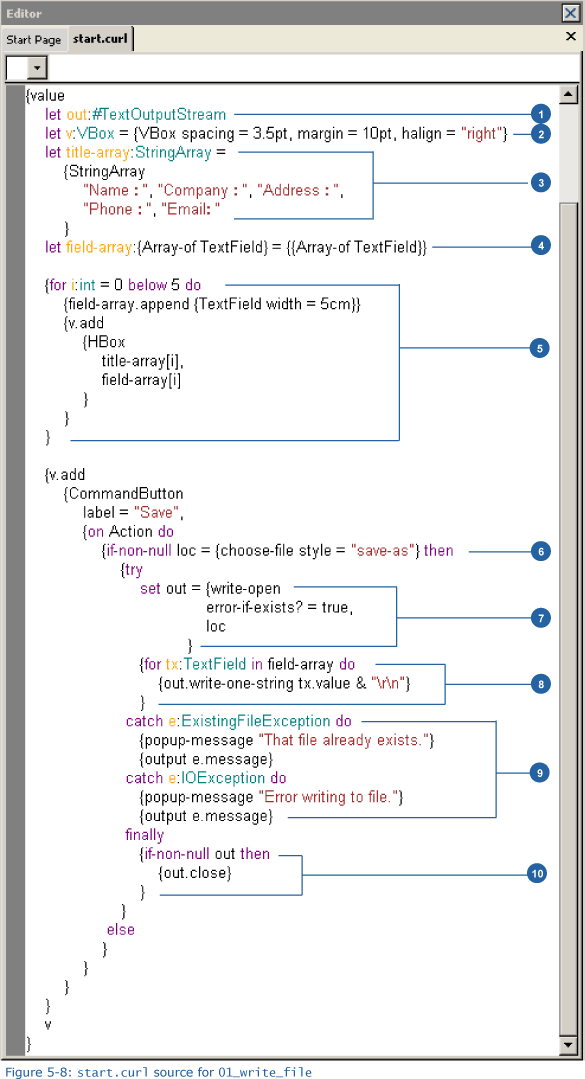
+- Curl Global Community (https://communities.curl.com)
+-- Forum: Tutorials (https://communities.curl.com/forumdisplay.php?fid=3)
+--- Forum: Public Training (https://communities.curl.com/forumdisplay.php?fid=4)
+---- Forum: Curl IDE Made Easy (https://communities.curl.com/forumdisplay.php?fid=6)
+----- Forum: Try 5: Reading Our Score Data (https://communities.curl.com/forumdisplay.php?fid=13)
+----- Thread: Page 4: Structure of a Program that Writes Data to a File (/showthread.php?tid=74)
Page 4: Structure of a Program that Writes Data to a File - ashimo - 06-20-2011
 Structure of the Program that Writes Data to a File
Structure of the Program that Writes Data to a File

The prcoess for writing data into a file is similar to reading data from a file.
1. Declaring a TextOutputStream
Code:
let out:#TextOutputStreamTo write data into a file, we use TextOutputStream. In the same way as in Try 5-1, we declare this variable so it can have a null value.
2. Creating VBox for display
Code:
let v:VBox = {VBox spacing = 3.5pt, margin = 10pt, halign = right}We declare a VBox, which is used for displaying the layout. We also specify spacing property which defines the spacing between objects, and the margin attribute that defines the amount of white space around the outside edges. The property halign is used to align all child objects to the right side of the VBox.
3. Declaring the character string array used for the titles
Code:
let title-array:StringArray =
{StringArray
Name: , Company: , Address: ,
Phone: , Email:
}We declare the above character strings as an array. These will eventually be displayed in the layout.
4. Declaring the input field array
Code:
let field-array:{Array-of TextField} = {{Array-of TextField}}We create the array for the input text fields. The initial value is an empty array, that is, one that does not contain any elements.
5. Adding the input fields to the layout
Code:
{for i:int = 0 below 5 do
{field-array.append {TextField width = 5cm}}
{v.add
{HBox
title-array+,
field-array+
}
}
}This time, we use the for expression to iterate over a specified range. Because we’ve specified below, the processing is not performed when i = 5 and the loop ends at that point. For each iteration of the for expression, we add a new TextField to the array. Finally, in the VBox used for the layout, we add an element from the title-array and one from the field-array.
6. Specifying a location for the file
Code:
if-non-null loc = {choose-file style = save-as} thenIn Try 5-1, we specified the URL of a file directly in the program text. In this example, however, we use a procedure called choose-file. choose-file pops up a Save as dialog box. If the user then specifies a file, that file's URL is returned as a return value.
7. Opening a File
Code:
set out = {write-open
error-if-exists? = true,
loc
}To write data into a file, we use the write-open procedure. With write-open, if the specified file already exists, by default the data in that file will be overwritten.
We can also call write-open in a way that prohibits the overwriting of an existing file. If we specify error-if-exists ?= true and we attempt to write data to an existing file, an exception called ExistingFileException will be thrown.
Note that if we want to append data to a file, we would use append-open instead of write-open.
8. Writing data
Code:
{for tx:TextField in field-array do
{out.write-one-string tx.value & "\r\n"}
}Using the write-one-string method, we can write a single character string. We can also use the for expression to obtain, in order, each TextField in an array, and then write the obtained values into a file. \r\n is used to indicate a carriage return and newline respectively.
In the same way as for reading data, there are several different methods for writing data such as write, write-one, and write-one-string. Please consult the Curl documentation for a full listing.
9. Handling an exception
Code:
catch e:ExistingFileException do
{popup-message That file already exists.}
{output e.message}
catch e:IOException do
{popup-message Error writing to file.}
{output e.message}Here, we use multiple catch clauses to perform the exception processing.
10. Closing the files
Code:
{if-non-null out then
{out.close}
}We have to close the file in exactly the same way as when we read data.
 Privileges and choose-file
Privileges and choose-fileCurl applets without the necessary privileges cannot freely access local resources. If, however, we use the choose-file procedure to specify the location of a file (like we did in Try 5-2), then even applets without special privileges can access user files. For an explanation of privileges, see Try 0 Page 2 or the Curl documentation.